Viking Ships › Neolithic Period » Ancient origins
Articles and Definitions › Contents
- Viking Ships › Antique Origins
- Neolithic Period › Ancient History
Ancient civilizations › Historical and archaeological sites
Viking Ships › Antique Origins
Definition and Origins
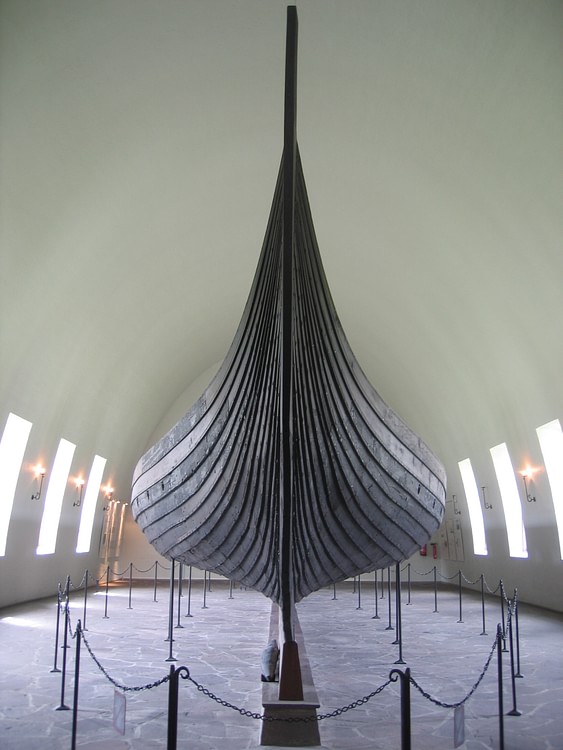
Viking ships were built by the Scandinavians during the Viking Age (c. 790 CE - c. 1100 CE) and were used both within Scandinavia and beyond for purposes ranging from being the most important means of transport to trade and warfare. Viking expansion, moreover, would not have been possible without ships. One of the most famous images connected with the Vikings is that of the dragon-headed longships, red-and-white striped sails giving it deadly speed and carrying its bloodthirsty warriors to their destinations of plunder. However, Viking ships came in many different forms, among which there were big-bellied cargo ships and, indeed, the speedy longships which facilitated raiding and gave the Vikings the edge over their contemporaries, but which far from always had the intricately carved dragon-heads that are so entrenched in popular imagination. Annoyingly, the archaeological record paints a rather patchy picture, as wood is not headstrong enough to stand the test of time very well, and our knowledge of early Viking Age ships comes almost exclusively from a handful of ship burials, although later on in the Viking Age sunken ships pop up to broaden our knowledge a bit.
ORIGINS & CONSTRUCTION OF THE CLASSIC VIKING SHIP
Following from the fact that in Scandinavia one cannot move very far without having their journey harshly interrupted by rivers, lakes, fjords, various straits, and open sea, Scandinavians came to their senses early on; depictions of ships in stone (in burialsettings) and metal are dated to c. 4000-2300 BCE, connecting with the use of wooden war canoes in the Bronze Age.
THE ADDITION OF SAILS IS WHAT TURNED VIKING SHIPS INTO THE QUICK & DEADLY CONTRAPTIONS THAT BECAME ESSENTIAL TO THEIR RAIDING STRATEGIES.
The earliest find we have of a plank-built vessel is the 19 meters long, 2-meter wide Hjortspring war canoe found in southwest Denmark and dating to c. 350 BCE. The next big find is that of the Nydam ships – three boats preserved in a sacrificial deposit in Denmark, the largest of which was around 23,5 meter long and around 3,5 meter wide – which date to c. 350 CE. They used oars instead of the earlier paddles and already showcase the lapstrake (or clinker-built) technique, in which the hull planks overlap; both of these features were carried on into Viking times. Although before the Viking Age most boats had their planks lashed together, iron rivets began being used by some pioneering shipbuilders as early as the 3rd century CE – another element that would become central to Viking ships.
By the time the Viking Age came around the basic idea behind producing something that would not sink at the merest glimpse of water had thus long since taken shape. Viking shipbuilders created watertight shells by first laying the keel and stems, then building up overlapping planks riveted to their neighbours (the lapstrake technique) one by one. This shape was then further stabilised by ribbing which was inserted inside the planking; this whole sturdy construction method is known as shell building, and it was the universal way of building ships throughout northern Europe all the way until the late Middle Ages.
Other features and their effects are described by WW Fitzhugh:
The addition of oars and sails gave Viking boats an advantage over all other watercraft of their day in speed, shallow draft, weight, capacity, maneuverability, and seaworthiness. Viking boats were designed to be dragged across long portages as well as to withstand fierce ocean storms. Such ships gave the Vikings the ability to trade, make war, carry animals, and cross open oceans and at the same time provided sufficient protection and security for the crew. (Fitzhugh, 15).
Sails – without which Viking exploration across the sea would have been profoundly more difficult - were actually a rather new element that only (re)appeared in Scandinavia towards the end of the 7th century CE, probably as a result of increased mercantile contacts with northern Europe, where sails were very much in fashion. The addition of sails is what turned Viking ships into the quick and deadly contraptions that became essential to their raiding strategies.
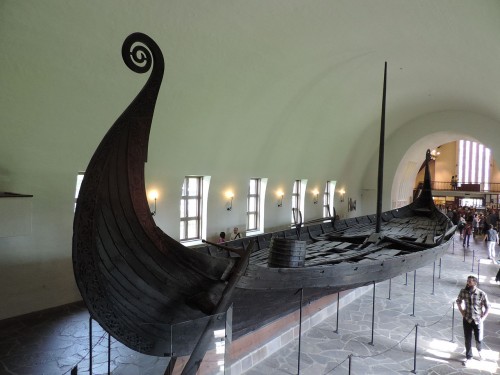
Oseberg Viking Ship
Access to enough sturdy timber to foresee in the Vikings' heavy demand for ships was luckily not much of an issue in woodland-covered Scandinavia, although oak – the first-choice pick - did not grow in the northern parts, where pine was used instead. With no saws in sight in northern Europe until the 13th century CE, Scandinavian craftsmen created planks by splitting tree trunks that were differently shaped depending on where they were to be used in the ship; floor planks were deep and narrow towards the keel, but broad and flat towards the tops where more flexibility was required. Iron, used both for tools and for fastenings such as rivets, was also so readily available that even farmers with a decent degree of wealth could source enough materials and manpower to build themselves a ship.
EARLY TYPES OF VIKING SHIPS
With the Viking raids kicking off just before 800 CE, we obviously know that by then the Scandinavians were capable of producing seaworthy, sailing vessels. The problem is that most of the ships that date back to this early stage of the Viking Age now seem to decorate our ocean floor or are decayed beyond recognition. So, in terms of tangible remains, our image of Viking ships is visually ruled by the rich ship burials containing the Oseberg (c. 820 CE), Gokstad, and Tune (both c. 900 CE) ships found in Oslo fjord in Norway.
The Oseberg ship is the earliest preserved Scandinavian sailing ship and comes in at 21,5 meters long, 5,1 meters broad, with room for 15 pairs of oars; broader (and deeper, too) than for instance the slender Nydam ship and the slim longships that would appear towards the end of the 10th century CE. Beautifully decorated with wood-carvings, the Oseberg was probably associated with the lofty tops of society, and although she was seaworthy and has all the main Viking ship features, she was not yet as capable as later ships. The already much more seaworthy Gokstad was a little larger and considerably deeper, and also had oarlocks; sailing ships benefited from retaining oar-support, too. Both of these seem to have been fairly robust and all-round vessels that could be used in both warfare and for transport purposes (possibly fitting into the kjóll ship type). The Tune ship was sort of a sized-down version of the Gokstad, with a similar purpose.

Oseberg Animal Head
However, more dedicated warships were also around at this point in time, with the term knarr (or knǫrr, plural knerrir ) seemingly indicating early warships with backward-curving stems. Finds such as the small-ish warship from Ladby, Denmark found in a ship burial dated to c. 925 CE, which is lower, slimmer, and faster than the Oseberg and Gokstad ships, show that by the end of the 9th century CE specialisation was already occurring throughout Scandinavia. The warship's main purpose was not to fight sea-battles (although these did occasionally occur) but rather to navigate sheltered waters to transport its fearsome warrior crew to a point of interest, dropping them off and swiftly picking them and their loot back up again when the moment came. Bigger-bellied all-rounders, instead, could properly handle open waters and could carry both people – warriors or not – and goods.
A VISIBLE INCREASE IN SPECIALISATION
Properly specialised cargo ships do not appear in our record (which does not mean they did not exist earlier on, however!) until the 10th century CE, which is also when warships become longer and more slender to the point they can confidently be called longships and begin to appear more frequently than before. Old Norse terminology specialises here, too, with the knarr now attached to the new cargo ships (which also had backward-curving stems, explaining why the term could carry over), while longships were potentially called skeiðar (sing. skeið ) if they were extremely long, serpent- or drakkar ships when dragon-heads were present, and snekke/ snekkja when slightly smaller.
ON LONG DISTANCES THE VIKINGS TRIED TO ISLAND-HOP OR GET WITHIN SIGHTING RANGE OF KNOWN LANDMARKS, AND RELIED ON THE SUN & STARS, WAVES & WIND, AND CLOUDS & ANIMALS.
Generally seen as one of the most important points of shipbuilding progress in the later Viking Age, cargo ships relied heavily on the sail and were sailable by a small crew while having a large carrying capacity. The Hedeby ships, for instance, which are dated to c. 1025 CE, might have been able to hold as much as 60 tons of goodies. Longships, on the other hand, used both oars and sails to reach their frighteningly high speeds which were so instrumental to the Viking raiders' hit-and-run tactics.They were also narrower than most of the ships from the early Viking Age; the Viking Ship Museum in Roskilde, Denmark, states that archaeologically, ships have to be at least five times as long as they were wide to be classified as longships. The longest known longship, known as Roskilde 6, dates to after 1025 CE and with its staggering length of 36 meters she helps illustrate the fact that longships were made ever longer during the Late Viking Age. Besides these two subtypes, which remained in use throughout the rest of the Viking Age, there is plenty of indication that a load of different, smaller boats would have cluttered up the Scandinavian waterways too.
The two types reflect changes in Scandinavian society which took place during the 10th century CE. Kingdoms expanded and the power of kings and chieftains rose, and because of the abundance of water and waterways, political power was inextricably connected with maritime might – which is where the longships came in handy. At the same time towns grew out of earlier trading centres, taking in ever more trade goods which all needed to be profitably transported, not just close to home but also to the North Atlantic Viking territories such as Scotland and Iceland. People, cattle, and useful supplies were obviously also not going to swim those distances; dedicated, open-sea traversing cargo ships were clearly very useful in this regard.
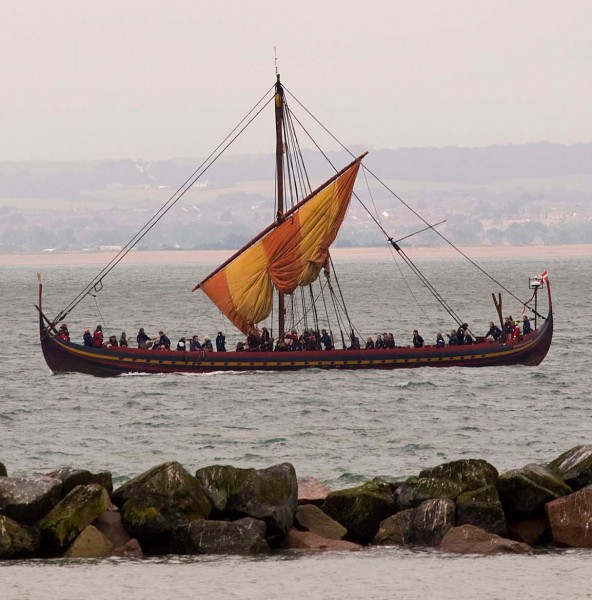
Viking Longship Replica
NAVIGATION
With Viking ships ready to scoot across any sort of distance, it obviously helped if its crew knew where to go. When staying close to the coast, navigation was generally not that much of an issue, as explanations highlighting landmarks such as funnily shaped cliffs and the amount of time between certain points would usually suffice. The Vikings often enhanced such features with stone cairns stuck on top of them. Atlantic voyages, however, where one could happily sail for days without sighting land at all, were a different matter altogether.
The compass, sea-chart or logs do not seem to have been known or used in Viking navigation. Instead, it looks like, on these long distances, the Vikings tried to island-hop or at least get within sighting range of known islands functioning as landmarks, while knowledge of sun and stars, common wave- and wind patterns, the way clouds behave over land, and the appearance of birds and sea mammals all helped out. The northern skies were too light during summertime for stars to be visible, however, and the sun is obviously not a reliable friend either: fog could cause ships to get disoriented at sea. Firsthand experience on the routes the Vikings sailed was obviously valuable; one can only imagine the uncertainty a Viking crew must have faced on first-time exploration journeys. Fierce Erik the Red, for instance, who would famously colonise Greenland, lost more than half of his ships during his first journey there, and the remaining ones were pushed back towards Iceland or wrecked altogether.
Some useful Viking routes were, for instance, from Denmark to the Mediterranean – an entirely coastal affair; from northern Denmark to England, which took two or three days; from western Norway to Scotland or the Irish sea probably via the Shetland and Orkney Islands, with only limited stretches of open sea; and the true long-haul, open-sea routes from Norway or Ireland to Iceland and Greenland. The early 14th-century CE Icelandic Hauksbók manuscript – which contains versions of older material, too – has instructions on how to get from Norway to Greenland and gives us a decent indication of the sorts of techniques and experiences the Viking sailors had access to; the focus lies on a very detailed description which adapts the way landmarks help out coastal navigation for use on the open seas.
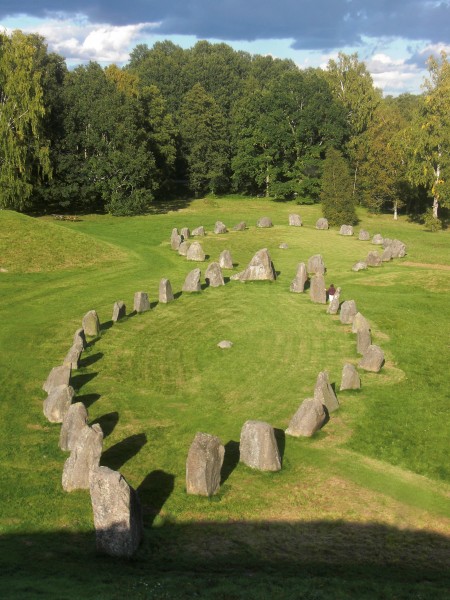
Scandinavian Stone Ship Burial
PLACE IN SOCIETY
Ships were clearly pivotal to Scandinavian society as a whole as in a landscape with so many waterways ships were used in every rung of society, including the highest; Viking rulers heavily depended on ships to reach (and consequently exercise control over) all the nooks and crannies along their territories' coastline or rivers. These same waterways moreover provided a much more convenient way of transporting goods and facilitated quicker communication than overland, also across longer distances to overseas settlements.
Culturally, Scandinavian ships burst through the barrier of history to emphasise their importance through the many ship burials that have been unearthed across Scandinavia even beginning before the Viking Age. The simplest form were graves marked by stones laid out in the pattern of a ship, but, more spectacularly, occasionally actual full-fledged ships were stuck into the grave -mounds. Imagine a trench with a ship inside it, covered by a mound, with generally at least one human body buried inside it, usually in a small chamber amidships or laid out on the deck. An enormous variety of grave goods and personal possessions, subject to great regional variation, accompanied the dead, and animal sacrifices were also common. The Oseberg ship burial – the richest Viking grave ever found - for instance, contained perhaps as much as 20 decapitated horses alongside its human occupants: a noblewoman and (probably) her handmaid. Sometimes the vessels were burnt, though.Macabrely, Viking ship burials, in particular, seem to be connected with human sacrifice, as seen in many ship-related graves containing people who had been deliberately killed (as evidenced by their decapitation, stabbing, broken necks, etc.) to tag along with the grave's main occupant.
Of course, Viking expansion and overseas influence would never have been possible without technologically sound ships.Merely in terms of exploration and colonisation, their ships allowed the Vikings to reach and settle in the British Isles, Iceland, Greenland, through the Mediterranean, and even across to Newfoundland in North America ('Vinland'). The speed and agility of their vessels turned their quick hit-and-run tactics into a big hit, thus playing a key role in warfare, too – the option of oars and their shallow draft allowing the ships to drop its crew off virtually anywhere, even close to almost landlocked targets such as Paris. This, then, is where the nightmare-image of dragon-heads descending upon unprepared targets must have really come alive for the Vikings' victims.
Neolithic Period › Ancient History
Definition and Origins
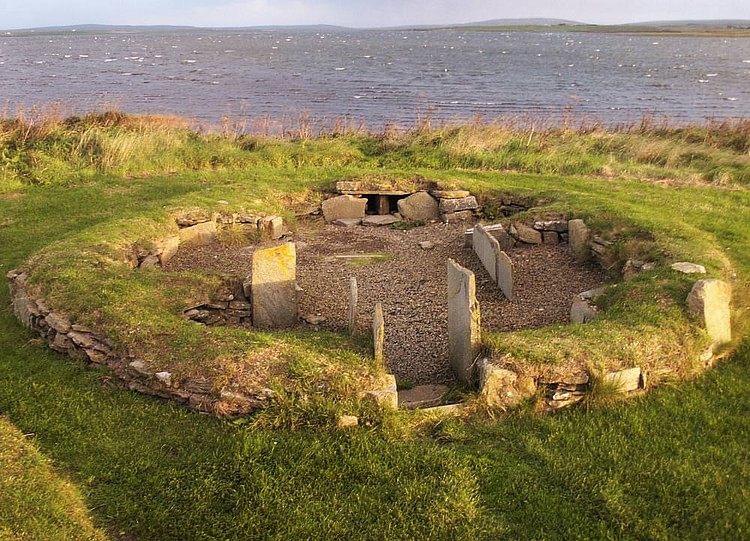
The term Neolithic Period refers to the last stage of the Stone Age - a term coined in the late 19th century CE by scholars which covers three different periods: Palaeolithic, Mesolithic, and Neolithic. The Neolithic period is significant for its megalithic architecture, the spread of agricultural practices, and the use of polished stone tools.
CHRONOLOGY
The term Neolithic or New Stone Age is most frequently used in connection with agriculture, which is the time when cereal cultivation and animal domestication was introduced. Because agriculture developed at different times in different regions of the world, there is no single date for the beginning of the Neolithic. In the Near East, agriculture was developed around 9,000 BCE, in Southeast Europe around 7,000 BCE, and later in other regions. Even within a specific region, agriculture developed during different times. For example, agriculture first developed in Southeast Europe about 7,000 BCE, in Central Europe about 5,500 BCE, and Northern Europe about 4,000 BCE. In East Asia, the Neolithic goes from 6000 to 2000 BCE.
THE DEVELOPMENT OF NEOLITHIC CULTURE APPEARS TO HAVE BEEN A GRADUAL RATHER THAN A SUDDEN CHANGE.
Pottery is another element that makes the dating of the Neolithic problematic. In some regions, the appearance of pottery is considered a symbol of the Neolithic, but this notion makes the term Neolithic even more ambiguous, since the use of pottery does not always occur after agriculture: in Japan, pottery appears before agriculture, while in the Near East agriculture pre-dates pottery production.
All these factors make the starting point of the Neolithic somewhat fuzzy. It should be remembered that the origin of the term lies in a late 19th century CE classification system (detailed above) and we must keep in mind its limitations.
A REVOLUTION?
In order to reflect the deep impact that agriculture had over the human population, an Australian archaeologist named Gordon Childe popularized the term “Neolithic Revolution” in the 1940s CE. However, today, it is believed that the impact of agricultural innovation was exaggerated in the past: the development of Neolithic culture appears to have been a gradual rather than a sudden change. Moreover, before agriculture was established, archaeological evidence has shown that there is usually a period of semi-nomadic life, where pre-agricultural societies might have a network of campsites and live in different locations according to how the resources respond to seasonal variations. Sometimes, one of these campsites might be adopted as a basecamp; the group might spend the majority of time there during the year exploiting local resources, including wild plants: this is a step closer to agriculture. Agriculture and foraging are not totally incompatible ways of life. This means that a group could perform hunter-gatherer activities for part of the year and some farming during the rest, perhaps on a small scale. Rather than a revolution, the archaeological record suggests that the adoption of agriculture is the result of small and gradual changes.
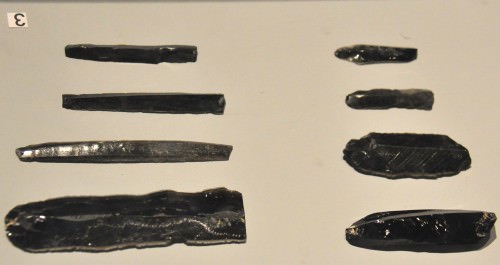
Obsidian Tools
Agriculture was developed independently in several regions. Since its origin, the dominant pattern in these separate regions is the spread of agricultural economies and the reduction of hunting and gathering activities, to the point that today hunting economies only persist in marginal areas where farming is not possible, such as frozen arctic regions, densely forested areas, or arid deserts.
Major changes were introduced by agriculture, affecting the way human society was organized and how it used the earth, including forest clearance, root crops, and cereal cultivation that can be stored for long periods of time, along with the development of new technologies for farming and herding such as plows, irrigation systems, etc. More intensive agriculture implies more food available for more people, more villages, and a movement towards a more complex social and political organization. As the population density of the villages increase, they gradually evolve into towns and finally into cities.
DEVELOPMENTS DURING THE NEOLITHIC
By adopting a sedentary way of life, the Neolithic groups increased their awareness of territoriality. During the 9600-6900 BCE period in the Near East, there were also innovations in arrowheads, yet no important changes in the animals hunted were detected. However, human skeletons were found with arrowheads embedded in them and also some settlements such as Jericho were surrounded with a massive wall and ditch around this time. It seems that the evidence of this period is a testimony of inter-communal conflicts, not far from organized warfare. There were also additional innovations in stone tool production that became widespread and adopted by many groups in distant locations, which is evidence for the existence of important networks of exchange and cultural interaction.

Neolithic Variscite Necklace
Living in permanent settlements brought new ways of social organization. As the subsistence strategies of Neolithic communities became more efficient, the population of the different settlements increased. We know from anthropological works that the larger the group, the less egalitarian and more hierarchical a society becomes. Those in the community who were involved in the management and allocation of food resources increased their social importance. Archaeological evidence has shown that during the early Neolithic, houses did not have individual storage facilities: storage and those activities linked to food preparation for storage were managed at village level. At the site of Jarf el Ahmar, in north Syria, there is a large subterranean structure which was used as a communal storage facility. This construction is in a central location among the households and there is also evidence that several rituals were performed in it.
TOWARDS THE END OF THE NEOLITHIC ERA, COPPER METALLURGY IS INTRODUCED, WHICH MARKS A TRANSITION PERIOD TO THE BRONZE AGE.
Another site in northern Syria named Tell Abu Hureyra, displays evidence for the transition from foraging to farming: it was a gradual process, which took several centuries. The first inhabitants of the site hunted gazelles, wild asses and wild cattle.Then, we see evidence of change: gazelle consumption dropped and the amount of sheep consumption rose (wild in the beginning and domesticated in the end). Sheepherding turned into the main source of meat and gazelle hunting became a minor activity. Human remains show an increase of tooth wear of all adults, which reflects the importance of ground cereal in the diet. It is interesting that once pottery was introduced, tooth wear rates decreased, but the frequency of bad teeth increased, which suggests that baked food made from stone-ground flour was largely replaced by dishes such as porridge and gruel, which were boiled in pots.
THE END OF THE NEOLITHIC
Towards the end of the Neolithic era, copper metallurgy is introduced, which marks a transition period to the Bronze Age, sometimes referred to as the Chalcolithic or Eneolithic Era. Bronze is a mixture of copper and tin, which has a greater hardness than copper, better casting properties, and a lower melting point. Bronze could be used for making weapons, something that was not possible with copper, which is not hard enough to endure combat conditions. In time, bronze became the primary material for tools and weapons, and a good part of the stone technology became obsolete, signalling the end of the Neolithic and thus, of the Stone Age.
LICENSE:
Article based on information obtained from these sources:with permission from the Website Ancient History Encyclopedia
Content is available under License Creative Commons: Attribution-NonCommercial-ShareAlike 3.0 Unported. CC-BY-NC-SA License